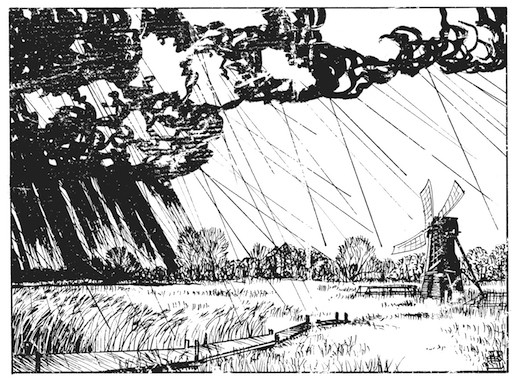 Wicken Fen © Paul Binnie, courtesy of Faber and Faber
Wicken Fen © Paul Binnie, courtesy of Faber and Faber
As the sun sinks lower, and the temperature falls, the pattering rain slows imperceptibly and stops – and within moments we are rioted around by goldfinches with their end-of-school chatter; there are sudden greenfinches in the hedges, too, and great tits calling, and the silvery notes of a robin trickle like water from somewhere in the carr. They’ve been waiting out the rain and now’s their last chance to feed before darkness falls, so they must make the most of it: it is as though the landscape has shaken birds from its hedges and thickets as my dog shakes water from her fur.
The air is soft and clear but the day’s rain continues to sink silently into the fields and fens. The land here is so flat it will hold on to the water for a long time before it drains north-east towards the Wash; but drain it will: first into the peat, then by degrees into the field drains and lodes, and to the tributaries, passing through pumping stations and locks and sluices as it goes, then into the River Witham, the Welland, the Nene or the Great Ouse, and eventually into the chill North Sea. As it flows, the dykes and watercourses will be lined with another layer of fine silt; the course of old, lost rivers can still be seen across arable land in the Fens, raised up, counter-intuitively, above the surrounding land by layers of sediment, and known as roddons.
The peat here began forming 4,500 years ago, and as long as it’s kept wet it can lock up thirty times more carbon than if the same area was forested: a precious natural resource. Once it was cut and dried for fuel, and nowadays its rain-retentive properties have led it to be prized by gardeners – though awareness is growing of the devastating effects of peat extraction, in terms of habitat loss, carbon release and flood defence. Over-drainage, to create farmland, also damages peat bogs and fens; unlike a bathroom sponge, when peat has dried out it shrinks and never swells again, which is why large parts of the Fens now lie well below sea level. At Holme Fen an iron post was sunk right down into the peat in the middle years of the nineteenth century; its top now stands four metres above ground level.
During that time the ability of these areas to absorb water, and defend us against floods, has been greatly reduced, so that when meltwater and heavy rains combine to overwhelm the Fenland rivers – as happened, devastatingly, in 1947 – or the sea walls necessary to protect the drained land are breached – as in 1953, with the loss of 307 lives – there’s precious little left to contain the floods. That’s why these days, low-lying East Anglia needs artificial drainage and vast coastal defences to keep it from being overwhelmed – yet even so, in December 2013 thousands of homes across three counties here had to be evacuated as huge surges demolished sea walls. Seaside towns were flooded, seven cliff-top homes collapsed, farms, wildlife and businesses were destroyed, and two people lost their lives. Afterwards, Norman Lamb, the MP for North Norfolk, described the area as ‘like a war zone’. But here’s the thing about water: the more it is denied the more powerful its incursions become. No wonder many people now believe that with sea levels rising, the Fens, with their protective, buffering function developed over thousands of years, should be restored, and swathes of agricultural land – some of it reclaimed from the sea as recently as the 1970s – finally relinquished.
Rain is on sale in the Caught by the River shop, priced £12.00
Melissa will be reading on the Waterfront stage at Caught by the River Thames on Saturday 6 August.